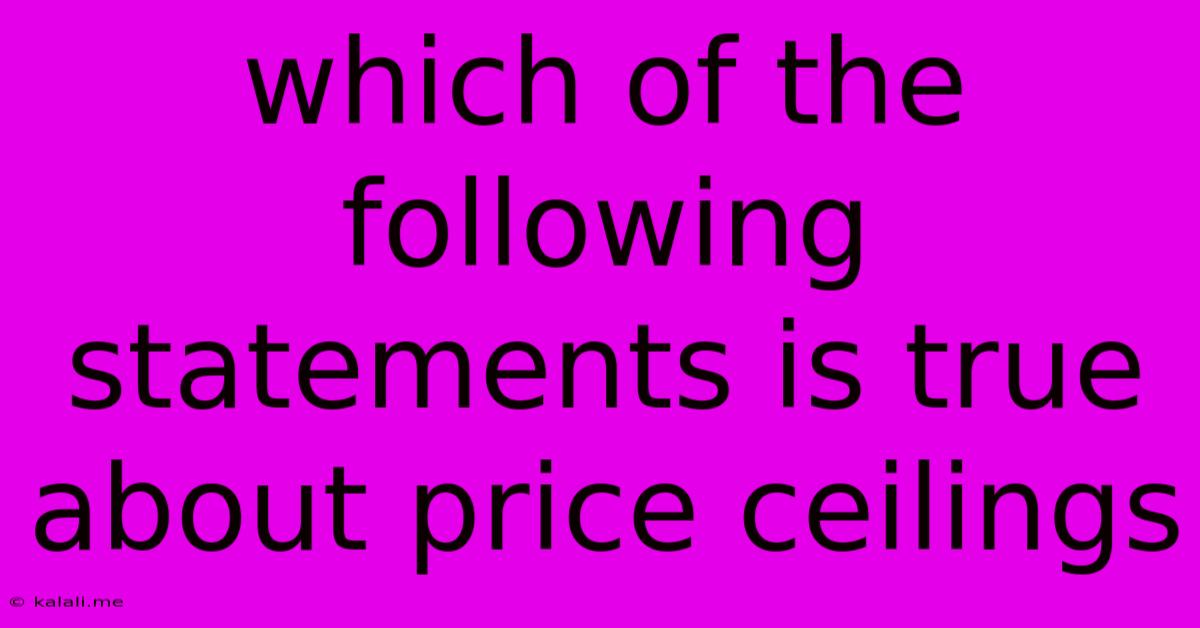Which Of The Following Statements Is True About Price Ceilings
Kalali
Jun 16, 2025 · 3 min read

Table of Contents
Which of the following statements is true about price ceilings? Understanding Price Controls and Their Impact
Price ceilings, a common topic in economics, are government-mandated maximum prices for goods or services. Understanding their impact is crucial for anyone interested in economics, public policy, or market dynamics. This article will clarify common misconceptions surrounding price ceilings and help you determine which statements about them are true. We'll explore their effectiveness, unintended consequences, and overall impact on market equilibrium.
What is a Price Ceiling?
A price ceiling is a legal maximum price that can be charged for a particular good or service. Governments typically implement price ceilings to make essential goods or services more affordable, especially for low-income consumers. Examples include rent control and price caps on essential medicines. However, intervening in the free market through price controls can have significant and often unintended consequences.
Common Misconceptions and the Truth About Price Ceilings:
Let's address some common statements about price ceilings and determine their accuracy:
Statement 1: Price ceilings always lead to lower prices for consumers.
This statement is false. While the intention of a price ceiling is to lower prices, the actual outcome depends on several factors, most importantly, whether the ceiling is set below the equilibrium price. If the ceiling is set above the equilibrium price, it's essentially ineffective – the market will naturally find its equilibrium without interference. However, if the ceiling is set below the equilibrium price, it can indeed lead to lower prices for some consumers who are able to obtain the good or service.
Statement 2: Price ceilings increase the quantity supplied of a good or service.
This statement is false. Price ceilings generally lead to a decrease in the quantity supplied. Since producers receive lower prices for their goods, they're less incentivized to produce and supply as much as they would at the equilibrium price. This can result in shortages, where demand exceeds supply.
Statement 3: Price ceilings create shortages.
This statement is often true, especially when the ceiling is set significantly below the equilibrium price. When the price is artificially lowered, demand increases while supply decreases, creating a gap – a shortage. This can lead to long lines, rationing, and a black market where goods are sold illegally at higher prices.
Statement 4: Price ceilings always benefit consumers.
This statement is false. While price ceilings might benefit some consumers by offering lower prices, they can negatively impact other consumers who may not be able to access the good or service due to shortages. Furthermore, producers may suffer reduced profits or even go out of business, leading to decreased overall supply in the long run. This also hurts consumers in the long run, as reduced supply can lead to higher prices eventually.
Statement 5: Price ceilings are an effective way to solve market failures.
This statement is partially true, but with caveats. While price ceilings can address specific market failures, like monopolies exploiting consumers, they're often a blunt instrument. Their effectiveness depends heavily on the specific market context and the price ceiling level relative to the equilibrium price. Other policy interventions, such as subsidies or antitrust measures, might be more effective and less disruptive to market efficiency.
Conclusion:
Understanding the nuances of price ceilings is crucial for evaluating their impact on the economy. While they can temporarily lower prices for some consumers, they often create shortages, discourage production, and can lead to unintended negative consequences. Therefore, a careful cost-benefit analysis is essential before implementing a price ceiling, and often other policy solutions are more efficient and beneficial in the long term. The impact is context-dependent and requires thorough analysis, making a blanket statement about their efficacy difficult.
Latest Posts
Latest Posts
-
How To Create Clickable Image In Html
Jun 16, 2025
-
What Are The Factors Of 121
Jun 16, 2025
-
What Is A Theme Of The Passage
Jun 16, 2025
-
A Company That Provides Access To The Internet
Jun 16, 2025
-
Which Word Is Closest In Meaning To The Underlined Word
Jun 16, 2025
Related Post
Thank you for visiting our website which covers about Which Of The Following Statements Is True About Price Ceilings . We hope the information provided has been useful to you. Feel free to contact us if you have any questions or need further assistance. See you next time and don't miss to bookmark.